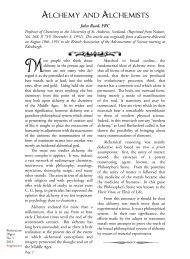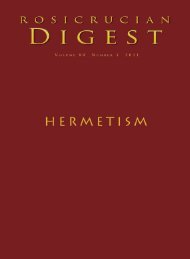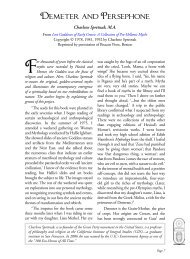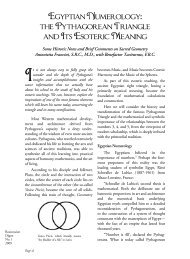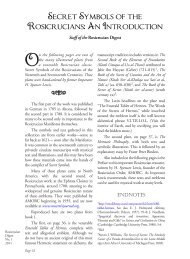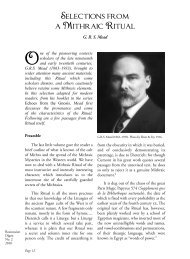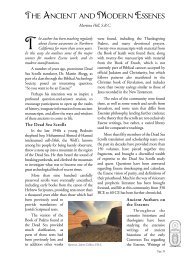Professor Lewis M. Hopfe - Kaveh Farrokh
Professor Lewis M. Hopfe - Kaveh Farrokh
Professor Lewis M. Hopfe - Kaveh Farrokh
You also want an ePaper? Increase the reach of your titles
YUMPU automatically turns print PDFs into web optimized ePapers that Google loves.
Rosicrucian<br />
Digest<br />
No. 2<br />
2010<br />
All theories of the origin of Mithraism<br />
acknowledge a connection, however<br />
vague, to the Mithra/Mitra figure of<br />
ancient Aryan religion. They all point to<br />
Persian influence in Asia Minor during the<br />
Hellenistic era and to the religious ferment<br />
of that period. All see the city of Tarsus<br />
as a starting point of Roman Mithraism.<br />
Plutarch’s single statement about the<br />
Cilician pirates carries enormous weight,<br />
and as a result, all theorists accept them<br />
as the missionaries who carried the new<br />
religion to Rome.<br />
The theories of the origin of Mithraism<br />
from Cumont to Ulansey remain only<br />
theories. Because of a dearth of literary<br />
evidence, we cannot be certain that<br />
Mithraism developed in a certain place<br />
or a certain time. However, the weight of<br />
scholarly opinion has clearly moved away<br />
from the long-held theory that Mithraism<br />
began in Persia and moved westward<br />
across Babylon, Syria, Asia Minor, and<br />
into Rome.<br />
Archaeological evidence is the<br />
strongest source of information about<br />
Mithraism. The remains of hundreds of<br />
Mithraic worship sites, the sculpting and<br />
painting of those sites, and the dedicatory<br />
plaques reveal a religion widespread across<br />
the Roman Empire from the second<br />
through the fourth centuries ce. Current<br />
archaeological evidence may bear out the<br />
critics of Cumont’s theory of the origin<br />
of Mithraism. If, as Cumont believed,<br />
Mithraism began as an Iranian cult and<br />
then moved west into Syria and on to<br />
Rome, one might expect to find wellestablished<br />
cult centers in Roman Syria.<br />
An examination of a map showing the<br />
locations of Mithraic centers in the<br />
Roman empire reveals that this is not<br />
so. While Mithraic materials have been<br />
found throughout the empire, the heaviest<br />
concentration is located in central Italy<br />
Page 18<br />
and northern Germany. East and west<br />
of these centers, archaeological evidence<br />
grows thinner. In Asia Minor Mithraic<br />
sites are relatively rare. They are even<br />
scarcer in Roman Syria. At the present<br />
only three Mithraea and a scattering of<br />
Mithraic artifacts have been located in<br />
Roman Syria.<br />
The Mithraea of Roman Syria<br />
Within the geographical dimensions<br />
of Roman Syria only three Mithraea have<br />
been discovered and excavated. They are<br />
located at Dura-Europas on the far eastern<br />
border of Roman Syria, at Sidon on the<br />
Mediterranean coast of Phoenicia, and at<br />
Caesarea Maritima on the Mediterranean<br />
coast of Roman Palestine. 12<br />
Dura-Europas is located on the<br />
extreme eastern border of Roman Syria on<br />
the banks of the Euphrates River. The city<br />
was established by Seleucid rulers about<br />
300 bce to protect trade routes. Roman<br />
occupation of the city began in 164 ce<br />
and continued until 256, when it was<br />
conquered by the Sassanians.<br />
During the ninety years of Roman<br />
occupation, Dura-Europas was apparently<br />
inhabited by diverse religious populations.<br />
Archaeological excavations carried on in<br />
the 1920s and 1930s revealed a Christian<br />
chapel, a Jewish synagogue and a<br />
Mithraeum. The results of these excavations<br />
were thoroughly published, 13 and as a<br />
result, students of Syrian Mithraism know<br />
more about the Dura-Europas Mithraeum<br />
than any other site.<br />
The Dura-Europas Mithraeum was<br />
apparently begun in the late second century<br />
ce. Its first phase was probably a small<br />
room in a private home. Unlike other<br />
Mithraea, which were built underground<br />
to simulate Mithras’s actions in the sacred<br />
cave, the Dura-Europas Mithraeum was




